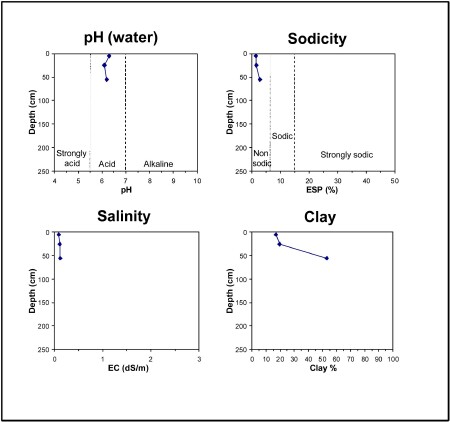GL77
| Site: GL77 | Land Unit: Gorae Basalt |
| Aust. Soil Class.: Ferric, Eutrophic, Brown, CHROMOSOL (confidence level 1) | |
| General Land Unit Description: This land unit has a variety of soil types occurring over a short distance. Ferrosols and Black Chromosols are found is association with the more dominant Ferric Brown Chromosols. The Brown Chromosols have been used to represent this area as they are deemed to be the major soil type, and due to restrictions of scale the other soil types have not been mapped as individual units. It must be noted however, that the better drained soils (Red Ferrosols / Dermosols) have a higher capability of supporting a range of land uses (e.g. viticulture) due to their favourable physical and chemical properties. |
Site Description:
| Slope: 3% | Geology: Quaternary basalt |
| Landform pattern: Undulating rises | Position in landscape: Upper slope |
| Internal drainage: Moderately well drained |
Soil Profile Morphology
| A11 | 0-10 cm | Dark brown (7.5YR3/3) loamy sand, apedal to weak structure, weak consistence when dry, many ferromanginferous nodules and a few medium subrounded basalt pebbles (2-10 mm), pH 6.3; transition to: |
| A12 | 10-40 cm | Dark brown (7.5YR3/3) sandy loam, weak polyhedral structure (2-10 mm), ferromangiferous nodules are abundant, pH 6.1; transition to: |
| Subsoil | ||
| B2 | 40-70 cm | Strong brown (7.5YR4/6) sandy clay, many distinct red mottles, weak subangular blocky structure (5-10 mm), very firm consistence when dry, ferromangaiferous nodules and angular basalt fragments are abundant, pH 6.2. |
Key profile features:
- Strong texture contrast between topsoil and subsoil
- Mottled subsoil
- Ferromangiferous nodules and coarse fragments are abundant throughout



